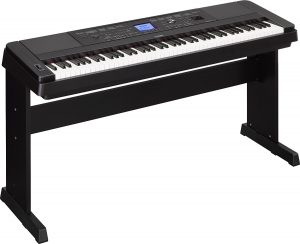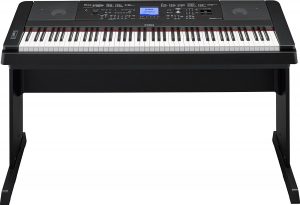The evolution of the piano as an instrument has seen a whole lot of developments and improvements. It had delighted homes, halls, and concert venues across the globe since its creation in the 18th century.
Pianos can be divided into four different categories. We have the vertical piano, horizontal piano, digital piano, and keyboards. Recently, digital pianos have become the most sought of all. This is because they have a number of desirable features. For instance, it is capable of producing a wide range of sounds, including the precision similar to traditional pianos. They can be incorporated in musical productions too. But most importantly, they are relatively affordable.
Choosing the right digital piano is no easy task to do. All its key features should be put into consideration to see if they fit your needs. Yamaha is no doubt one of the well-reputed brands in this industry with long years of experience. Such expertise can be clearly seen on the quality, design, and level of performance of its products.

Today, we are going to review the brand’s premium portable keyboard, the Yamaha DGX-660. Dubbed as a “Portable Grand,” this comes with a full 88-key keyboard. Many reviewers cannot get over its high quality and pristine grand piano sound. So here it goes.
The DGX-660 is the successor of Yamaha’s popular DGX-650. This new great digital piano comes with a bunch of exciting features, sounds, and effects that will take this instrument to the next level.
This instrument deserves to be called the Portable Grand. It has a beautiful piano sound, as well as many of other instruments’ sounds. This is basically a hybrid of a digital piano and an arranger of the keyboard. It comes with hundreds of songs, styles, and rhythms. But most musicians prefer this for its wireless compatibility.
Features
- Very versatile, featuring the typical DC in power port, stereo output, headphone jack, sustain pedal jack, auxiliary output, and microphone input
- Features 88-graded hammer standard keys and 192 note maximum polyphony
- 554 built-in sounds, 205 styles, 100 preset songs
- 41 types of Reverb effects, 44 Chorus, 26 Harmony, 237 DSP, and 5 Master EQ
- Four types of touch responses – soft, medium, hard, and fixed
- Comes in three different modes – layer, split, and duet
- Six track recorder lets you record and layer up to 6 multiple tracks all at the same time
- Style recommender assists you in playing a rhythmic style
- Piano room feature helps you pick any acoustic and piano choices to form your own setting
- Education Suite feature for lesson function
- 320 x 240 LCD display (with a score or lyric display function)
- With Pure CF sound engine
Pros
- Online apps are readily available
- Has a LED screen that can provide descriptions for each function
- Has different connections and ports
- Piano sound sample from the Yamaha CFIIIS Concert Grand
- MIDI and Audio recording capabilities
Cons
- Assembly is a little complicated
- A mic or an adapter is needed to connect the XLR microphone cables
- Not that portable at 30” tall, 55” wide, and 17.5” deep
- A bit heavy, weighing 61 pounds
- Very basic sustain pedal
Keyboard
It comes with a touch-responsive keyboard with 88 fully weighted keys. It features the Graded Hammer Standard (GHS) keyboard action, which is similar to that of the Yamaha P-45 and P-115 digital pianos. The GHS reproduces the feel of an acoustic piano with a heavier touch. Yamaha DGX-660 is also touch-sensitive. This means the harder you press the keys, the louder the sound it will produce. The keyboard has four preset settings – soft, medium, hard, and fixed.

Sound
Yamaha DGX-660 features a Pure CF sound engine, which can also be found in the Yamaha P-115, the P-255, and pianos from the Arius line. It has an impressive library of 10 other piano sounds, hundreds of other instrument sounds, and a wide range of sound effects. This instrument also comes with a Pitch Bend wheel, a master equalizer, and a Digital Signal Processing mechanism.
Speakers
Yamaha DGX-660 is packed with two 6W amplifiers. Its quality is further improved using the Intelligent Acoustic Control function, which automatically adjusts bass and tremble frequencies.
Modes
There are three modes offered by the DGX-660: split, layering, and duet. The Split Mode divides the keyboard into two parts. It allows the player to play two different instruments per hand. For example, the right-hand plays the piano, while the left for the drums.
The Layering Mode allows you to play two different sounds simultaneously. For example, one key can play both the organ and the piano. Lastly, the Duet Mode is suitable for beginners. The keyboard here is split into two similar halves. Each half can be used as an entirely separate keyboard.
Recording and Playback
Yamaha DGX-660 is compatible with both MIDI (SMF) and audio (WAV) format data. The MIDI format records the sequence of notes including their length and velocity. Apps like Windows Media Player, QuickTime, and Winamp can interpret MIDI data on your computer.
Meanwhile, the Audio records or plays back the actual keyboard sound. It lets you record up to 80 minutes per single recording. You can play it back on your mobile devices and even upload it to social media.

Lesson Function for Beginners
Newbies can take advantage of the Yamaha Educational Suite. This allows you to utilize MIDI songs for a left-hand, right-hand, or both hand lesson. This feature comes with three types of song lessons: Waiting, Your Tempo, and Minus One.
In the Waiting, the song will wait until you play the right notes as shown on the LCD screen. The virtual keyboard will show both the notes and the keys. The Your Temp lesson lets you try to play with the correct timing. You will notice the melody to slow down when you hit the wrong notes. Lastly, the Minus One lesson allows you to play a part of a song you want to practice (left or right hand. You will play it along with the playback of the other hand-part.
Conclusion
Overall, the Yamaha DGX-660 is a very versatile keyboard. You can definitely do many incredible things with this keyboard, thanks to the enormous library of sounds, songs, styles, and effects. The education feature with a virtual keyboard is a good learning tool for kids or beginners. It has great recording abilities too, allowing you to record your own music in no time.
The only drawback is its relatively bulky and heavy size. This means this is not recommended for gigs or paying out. But unless you can manage its transport, then why not?
The Yamaha DGX-660 is highly recommended for pianists who are looking for something more than just a piano. It can accommodate all pianists across different skill levels.



Thank you, great detailed video